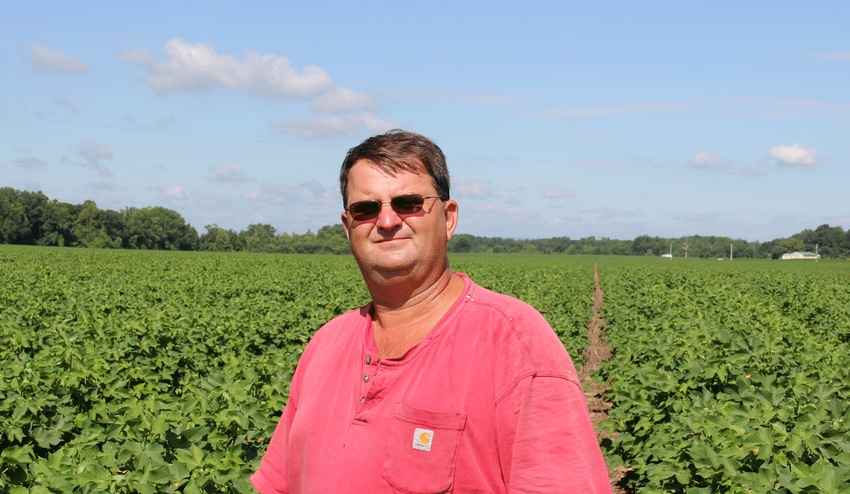
McMichen’s subsurface irrigation boosted his row-crop yields
McMichen and his father installed subsurface drip irrigation 10-12 inches deep on a 17-acre pivot corner in 1998 and then on an 18-acre field too small for a pivot in 2000.McMichen estimates his cost was $1,200 per acre to install the subsurface drip.
August 17, 2016

Much of northeast Alabama is suffering through its worst drought in nearly a decade. The drought ravaged much of the dryland corn with growers hoping the recent scattered rains can salvage the cotton and soybean crops.
Cherokee County farmer Nick McMichen says water is the singular best investment on his farm, and he has seen a huge return from subsurface drip irrigation. McMichen and his father installed subsurface drip irrigation 10-12 inches deep on a 17-acre pivot corner in 1998 and then on an 18-acre field too small for a pivot in 2000. McMichen estimates his cost was $1,200 per acre to install the subsurface drip.
“The subsurface drip irrigation was a sound investment. The 14 mil Netafilm tape is still functional today. We use a Netafilm disc filter system which is adjustable to the condition of the water source. We flush the tape out at the end of the growing season with chlorine. There has been no problem with emitters clogging. Our biggest concern has been rodents gnawing on the tape but as the ground settled the rodent problem eased up,” McMichen said.
Subsurface irrigation trainings
Two meetings will help growers explore their options on subsurface drip irrigation. They will be Aug. 23 at 6 pm at the Cherokee County Extension office in Centre, Alabama, and Aug. 24 at 6 pm at the Marshall County Farmers Federation in Guntersville, Alabama. Preregistration is required. Please call regional extension agent Eddie McGriff at 256-557-2375 or e-mail him at [email protected] if you plan on attending.
Speakers at the meeting will be Nick McMichen-A Grower’s Perspective of Subsurface Drip Irrigation; Dr. Ron Sorensen-Subsurface Drip Irrigation Options and Design; Subsurface Drip Irrigation Industry Representatives - Installation of Subsurface Drip; and NRCS-possibility of EQIP funding for subsurface drip irrigation.
The McMichens did all their own installation. “I learned a lot the hard way. The second field’s installation went much smoother than the first,” he said.
McMichen’s goal was three bales per acre of cotton with the drip irrigation, but last year he had his best cotton yield ever with over a four-bales-per acre average over his pivot and subsurface drip irrigation. Most years, even with good rainfall, he averages from 1-1.5 bales per acre more with the subsurface drip irrigation than his dryland fields. He averages 80 bushels per acre on his soybeans and 250 bushels per acre on his corn where he has his subsurface drip irrigation.
McMichen buried his tape every other row on 38-inch rows (76 inches apart) and originally fertigated but has since changed his row pattern twice and no longer fertigates. He notes his yield potential would be higher with fertigation. The irrigation tape is pressure compensating and he runs his pressure at 20 PSI to account for a ten-foot elevation in one field.
Finding a better, cheaper system
Ron Sorensen, research agronomist with the National Peanut Lab in Dawson, Ga., has been doing research on subsurface drip irrigation for over 15 years. His latest research has focused on burying 8 mil tape two inches deep every other row connecting into two-inch lay flat.
“This system is much cheaper than the thicker mil buried 10-12 inches deep. It runs $200-300 per acre not counting the filtration system. The filtration system, depending on the quality of water, may double the costs. The irrigation tape buried two inches deep has lasted at least five years and we often get eight years out both the subsurface tubing and lay flat,” he said.
“A disadvantage is that a grower may not be able to grow wheat with the two-inch system as the wheat roots may grow into the tubing at this shallow depth. We have not done any research on wheat to prove that it cannot be done. I do believe it is possible but we need more information before recommending it,” he said.
Sorensen’s research with the two-inch deep surface irrigation has gotten almost an eight time yield increase with corn (26 bushels per acre non-irrigated versus 205 bushels per acre with the subsurface drip) over a two-year period. Subsurface irrigated cotton yielded 1,858 pounds per acre versus 555 pounds per acre dryland over the same two-year period. He notes. “The subsurface drip paid for itself in the first year,” he said.
Sorensen cautions growers that design is critical. “There a lot factors to consider including water quality and filtration system along with flow rate. The lay of field and length of the rows are also important when designing the system. The drip tape will follow the contour of the rows if a grower’s GPS allows,” he said.
NRCS says growers may be eligible for EQIP funding for subsurface drip irrigation. Each county decides if they want to use the irrigation funding pool. They must have an irrigation history and be upgrading an older solid set or traveler. They also must have a certified irrigation design approved by NRCS engineering staff before installation. In the past there has been a limit of $30,000.
You May Also Like



